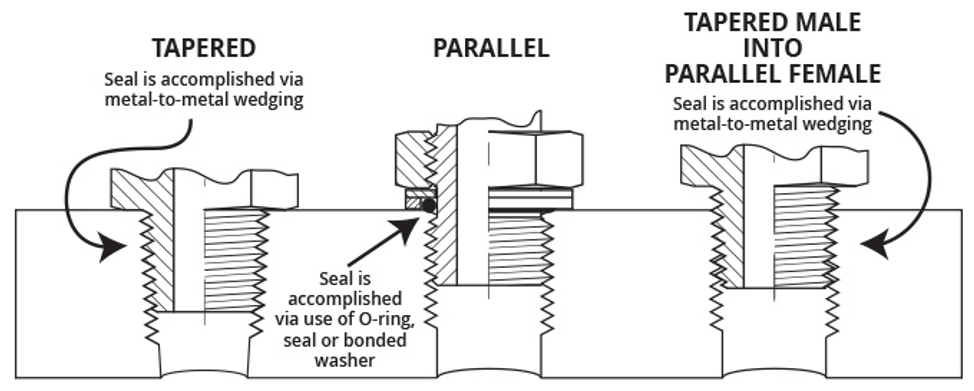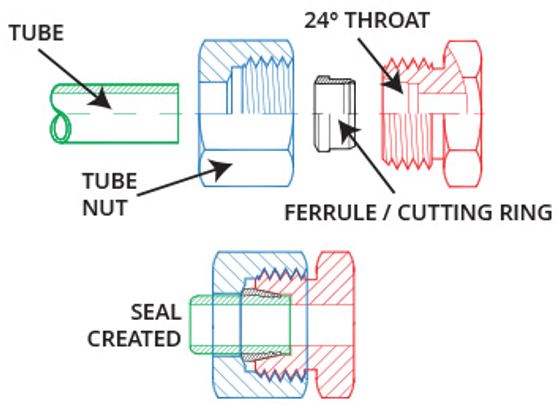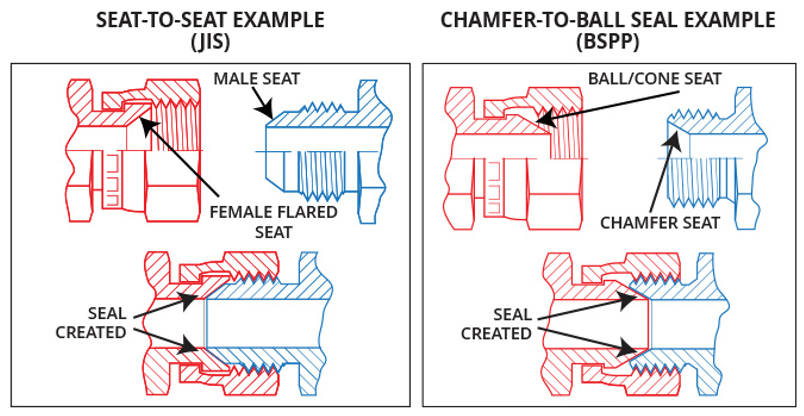
Fittings… Should You Tape It?
By Michael Teahan
Espresso machine fittings are ridiculously simple, yet poorly understood. It doesn’t help that there are numerous international standards that nearly sound alike, and some are close enough that more than a few have been wrenched together with Teflon tape and a prayer.
The goal with this piece is to make what is simple, simply understood, and rip off a few misconceptions at the same time.
While the rest of the world adopted the metric system and proclaimed its superiority for decades to our backward imperial infatuation, there is one vestige of our fractional past with which even the Europeans must contend:
There is no such thing as a metric fitting in an espresso machine. It may require a metric wrench and couple a metric tube, but the threads used to fit them are all pipe threads, and they are all fractional. The plumbing overlords have managed to keep things in inches and forced the world to comply. But not just any old pipe thread—not the kind we might find at Lowes—British pipe thread. Virtually all espresso equipment parts guides refer to them
as “gas fittings.”
There are two differences between British Standard Pipe (BSP) and National Pipe Thread (NPT) common here in North America: the first is that the diameter of the thread is very slightly larger with NPT, and the second is that the thread pitch per inch is close, but just different enough, to piss you off.
So, all espresso machine fittings are British pipe – some tapered, and some not – but the pitch is the same. Additionally, even flare fittings and ferrule fittings are British (usually straight), which makes mixing and matching in desperate situations a little easier.
Caveat: A few difficult manufacturers have tried to do some proprietary threads, usually joining two halves of a steam valve or pressure relief valve together. You may also find a Pavoni, Gaggia, or San Marco in the field with fine threads on the PRV and you will have to either source it or get really creative.
How to Make the Seal
Threads are either tapered – where the pitch of the male threads match that of the female fitting – or they are parallel with the same diameter from end-to-end.
Tapered fittings are designed to create a seal by tightening the male threads against the corresponding female threads. As they are tightened, the clearance between the threads of both fittings converge together. The seal is forming along the entirety of the mated threaded surface kind of like a wedge. Brass fittings deform slightly as they are tightened to form the seal, and, in a perfect environment, wouldn’t need any sealing aid like Teflon tape
or paste.
The challenge is that fittings often need to be oriented in a particular direction. For this reason, Teflon tape or paste is perfectly fine for tapered fittings. The forgiveness of tape and
paste assure a good seal across a broad spectrum of torque. It is perfectly fine to tape a tapered fitting.
Parallel pipe fittings are designed differently. The threads apply physical force drawing two fittings together to squeeze a sealing surface together. Fittings that use crush or Teflon washers,
end. ” width=”65″]

Mixed Marriages
The third fitting pictured above demonstrates what a lot of us have done in a pinch. With British pipe threads, the pitch is the same and it is possible to form a seal. The downside is that the amount of mated surface area is much less. This is an area where tape or paste can help bridge some of the gaps in the threads.
It is also possible, but not ideal, to fit an NPT tapered thread onto non-tapered parallel fitting. The difference is not just the taper and diameter, but the number of threads per inch. On an 1/8” fitting for example, you would see 27tpi on one and 28tpi on the other. You could muscle it on, but you’d have to be in a desperate place.
Fitting with Tubes
Virtually all fittings used to fit tubing is British Parallel Pipe, which means that the intended sealing surface is the pipe or ferrule on the pipe itself. In these scenarios, Teflon tape or paste is useless. For non-welded fittings, the ferrule is squeezed onto the copper pipe when the fittings are tightened. The metal of the ferrule is thinner at the base, allowing it to yield to pressure and form a tight seal to the copper. The face of the
ferrule is pressed against the fitting to complete the seal.

Soldered ball fittings are the gold standard. You aren’t relying on the thin wall of the brass against copper and the end cap is actually part of the pipe itself. The solder joint replaces the crimp fitting against the copper which can sometimes weaken the tube if overtightened.
The last method of sealing tubes is using flares. They rely upon the ductility of the copper to form a seal between the male fitting of the flare and the female seat. It’s a pretty basic seal that is reliable but creating the flare can stress the copper. As machines age, the copper becomes less ductile so every time a pipe is removed there is a risk of a fracture at the base of the flare.

Workarounds
No matter what you do, fittings will want to leak. When decalcifying a machine, threads melt away and fittings that used to line up perfectly… don’t. Snapping a pipe at the ferrule for a tube you don’t have on the truck, 40 miles from the shop, you need to find something that works.
Here’s a list, along with permission to use Teflon tape when, perhaps, you really shouldn’t:
If you have a cracked, unwelded ferrule, you can wrap the base of the ferrule with Teflon tape so that it compresses against the tube when tightened. It will behave like a nylon ferrule and maybe last just long enough to give you a chance to do a proper repair.
If you have a ball seat with a marred surface that doesn’t want to hold, the Teflon cap on top of a steam wand is forgiving enough to seal the ball end of the tube against the seat of a 3/8” fitting.
Teflon paste is better than tape, more forgiving, and won’t make the machine look like monkeys worked on it.
You should not reuse a copper crush washer because it’s designed to seal over a range and allow the fitting to be positioned. Once crushed, it won’t seal in the same orientation again. Solid copper and Teflon washers are used on fittings that need orientation and can be reused.
You can sometimes cheat and use fractional copper and ferrules to rebuild lines by reusing the threaded fittings. The good thing about compression fittings is that close counts.
The best thing to have on the truck is medium-strength thread lock. We used Loxeal green (similar to Loctite blue) because it wasn’t permanent, but allowed a fitting to make a solid seal in a position oriented the way you need it, even if it isn’t that tight.
Πηγή: coffee technicians guild


